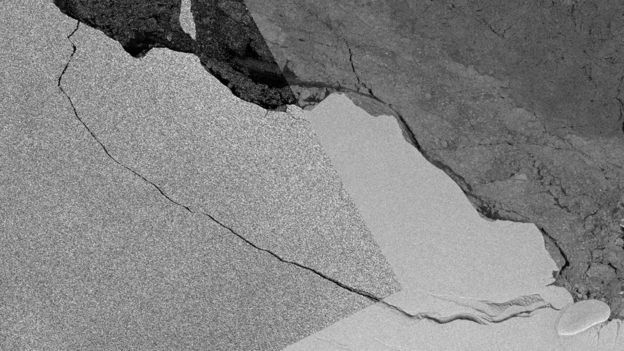One of the world’s largest ever icebergs – around a quarter of the size of Wales or four times the area of London – has broken off from Antarctica, recent satellite pictures have confirmed. The massive berg, which calved from the Larsen C Ice Shelf, is approximately 5,800 square kilometers in size and weighs almost a trillion tonnes.
A NASA satellite, which captures thermal pictures, seemed to show a crack that has been establishing for numerous years had lastly broken through and this was confirmed later by other, higher-resolution images. Though the berg has not yet drifted away from its location, which could be because it is grounded on underwater hills, or because of sea streams and winds.

Writing on the Project Midas website, which covers Antarctic research, researchers said:
“A one trillion tonne iceberg – one of the largest ever documented – has calved away from the Larsen C Ice Shelf in Antarctica. The calving happened sometime between Monday 10 July and Wednesday 12 July 2017, when a 5,800km2 piece of Larsen C lastly broke away. The iceberg, which is expected to be named A68, weighs more than a trillion tonnes. Its volume is twice that of Lake Erie, one of the Great Lakes.”
While the iceberg is enormous, it is around half the size of the biggest one ever documented, which was 11,000 square kilometers. It broke off the Ross Ice Shelf in 2000 and passed by New Zealand almost six years later.

A thermal picture captured by NASA’s Modis satellite seems to show the giant iceberg is no longer joined to the main ice shelf (NASA)
A line displaying the real ice edge was drawn on the purple thermal image captures by NASA, which shows the crack ranging in a loop from one stretch of coast to another. This was later confirmed by a greater resolution image captured by a various satellite.
The researchers said the iceberg itself would not have an influence on global sea levels as it was previously floating on the water. Though it may end up having a substantial effect as its exclusion could accelerate the flow of glaciers from the land into the sea.
“The calving of this iceberg leaves the Larsen C Ice Shelf decreased in area by more than 12%, and the landscape of the Antarctic Peninsula altered forever. Though the residual ice shelf will continue naturally to regrow, Swansea scientists have previously shown that the new arrangement is possibly less stable than it was prior to the rift. There is a risk that Larsen C may ultimately follow the example of its neighbor, Larsen B, which fragmented in 2002 following a similar rift-induced calving event in 1995.” the researchers said.
The iceberg could remain where it is – some have been known to stay in place for as long as 20 years – float away into the ocean currents in a huge single block or break up into minor bergs.
Professor Adrian Luckman, of Swansea University, a lead scientist on the Midas project, said:
“We have been expecting this event for months, and have been astonished how long it took for the rift to break through the last few kilometers of ice. We will continue to observe both the effect of this calving incident on the Larsen C Ice Shelf, and the fate of this huge iceberg. The iceberg is one of the biggest recorded and its upcoming progress is hard to forecast. It may stay in one piece but is more probable to break into small pieces. Some of the ice may remain in the area for decades, while parts of the iceberg may float north into warmer waters.”
Dr Anna Hogg, of Leeds University, who has been observing the crack on the ice shelf, said the thermal image had been confirmed by the Sentinel1 satellite.
“It also displays the iceberg hasn’t moved away from the position it was in when it was still joined by this small ice bridge,” she said.
Dr Hogg said this was not an infrequent thing for icebergs to do.
“Icebergs have remained in the same place for up to 20 years, they can become quite permanent,” she said.
Rod Downie, head of polar programmes at environmental charity WWF, said:
“The absolute scale of this natural calving incident is remarkable – we will need to redraw the map of the Antarctic Peninsula. And at the same time as this is Antarctica doing what Antarctica does, it shows just how delicate the polar areas are. The Polar Areas drive our oceans and atmosphere.
But west Antarctica has been through some of the most prompt rates of warming on the planet in current decades, and that’s not good news for iconic species such as Adélie or emperor penguins. This shows why we need to immediately and internationally confront climate change head on, beginning in the UK with the UK Government outlining how we plan to meet our international commitments to decrease carbon emissions.”
